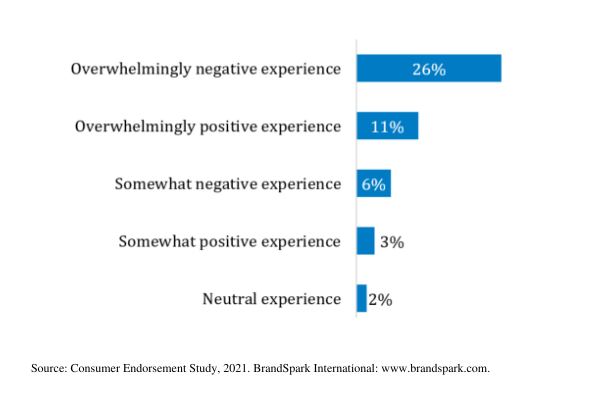As discussed in our recent webinar, ratings and reviews play a fundamental role in the purchase journey for all products both online and in store. More than 2/3rds of Canadian households rely on them to help inform their choices. However a brand has limited control over the organic generation of these reviews. Unlike other communication mediums brands are unable to control the amount of information that is provided in a review or if a review is actually helpful to other consumers. Further brands are unable to verify that a review came from an actual consumer, and try to maintain a stream of recent reviews. This becomes an issue as we know consumers are much more likely to post organic reviews when they have an overwhelmingly negative experience – even more than when they have an overwhelmingly positive experience.
Figure 1. Likelihood of posting an online review based on type of experience someone has

Accordingly there is a strong need for consumers and brands that products have informative, authentic consumer reviews. When properly executed, trustworthy incentivized ratings and reviews are the best option to fill product information gaps – serving consumers, brands and retailers while meeting regulatory requirements.
Our choice-based conjoint analysis on optimizing incentivized reviews
This insight came from consumer research BrandSpark recently conducted on ratings & reviews. The key hypothesis we tested was that an incentivized review can be just as impactful as a trusted one while meeting all legal and regulatory requirements. To do this we conducted a choice based conjoint methodology in which we tested 6 core variables (covering type of review, verified purchase, type of disclaimer, helpfulness rating, country of origin, recency of review, and location where posted) resulting in a model that could compare the results of over 13,000 different structures of reviews. The type of incentive provided was captured in the disclaimer – with six different options ranging from “none” to “I received this product for free.”
We knew from past research, and this study again verified, that consumers trust organic (or non-incentivized) reviews significantly more than incentivized ones. What our analysis focused on was if there was a combination of variables marketers could impact, in conjunction with various different incentive options, was it possible to achieve a trust level equal to a typical verified organic Amazon review.
While there were ways to improve trustworthiness within each of the factors, there were two key insights that stood out (beyond the rather obvious one that longer, more detailed reviews are better than shorter ones):
- The inclusion of a critical comment within an overall positive review description greatly increased trustworthiness.
- The incentivized review indicating that the reviewer had received a discount on the product had a very positive impact on trustworthiness vs. having received the received product for free.
Learning: Incentivized Reviews can be just as trusted as a standard organic one
When these factors were combined – a longer detailed review, including a negative/ critical observation and the “discount” disclaimer – it created the conditions where this “incentivized” review achieved comparable trust levels than the typical verified organic Amazon review. And this learning applied to both durable and FCG categories tested.
The benefits of discounts and constructive criticism
By only receiving a discount vs. getting the product completely for free, shoppers reveal they have spent their own money towards the purchase of the product. Meanwhile the critical comment can be viewed like constructive criticism – a great indicator the reviewer has really thought about their feedback and importantly have actually tried the reviewed product. In many cases, these critical comments also help create a positive feedback loop – helping identify who the product is NOT good for, which reduces the size of the group likely to have a very negative experience (and therefore more likely to post about their negative experience). Even when a reviewer received a product for free, as long as clearly disclaimed with sufficient detail and critical observations, this review could still attain high levels of trust.
How marketers can take action on this
Armed with this information, marketers can confidently move forward with incentivized rating and review programs that can help bolster the brand (and product sales), while helping fill shopper and retailer needs – a true win/win/win scenario. For many it will require ensuring they improve their content and targeting requirements with an inclusion of a critical observation, while making sure the review disclaimers are transparent and detailed and customized depending on whether the product was offered with a discount or provided for free.
Building trust in your marketing activities including ratings and reviews will lead to greater levels of product trial and sales with an ability to have your products stand out and command a price premium where appropriate and leads eventually to brand loyalty. If you’d like to learn more, contact BrandSpark or Shopper Army to gain the latest insights on consumer shopping trends and the highest quality trusted ratings and reviews.

